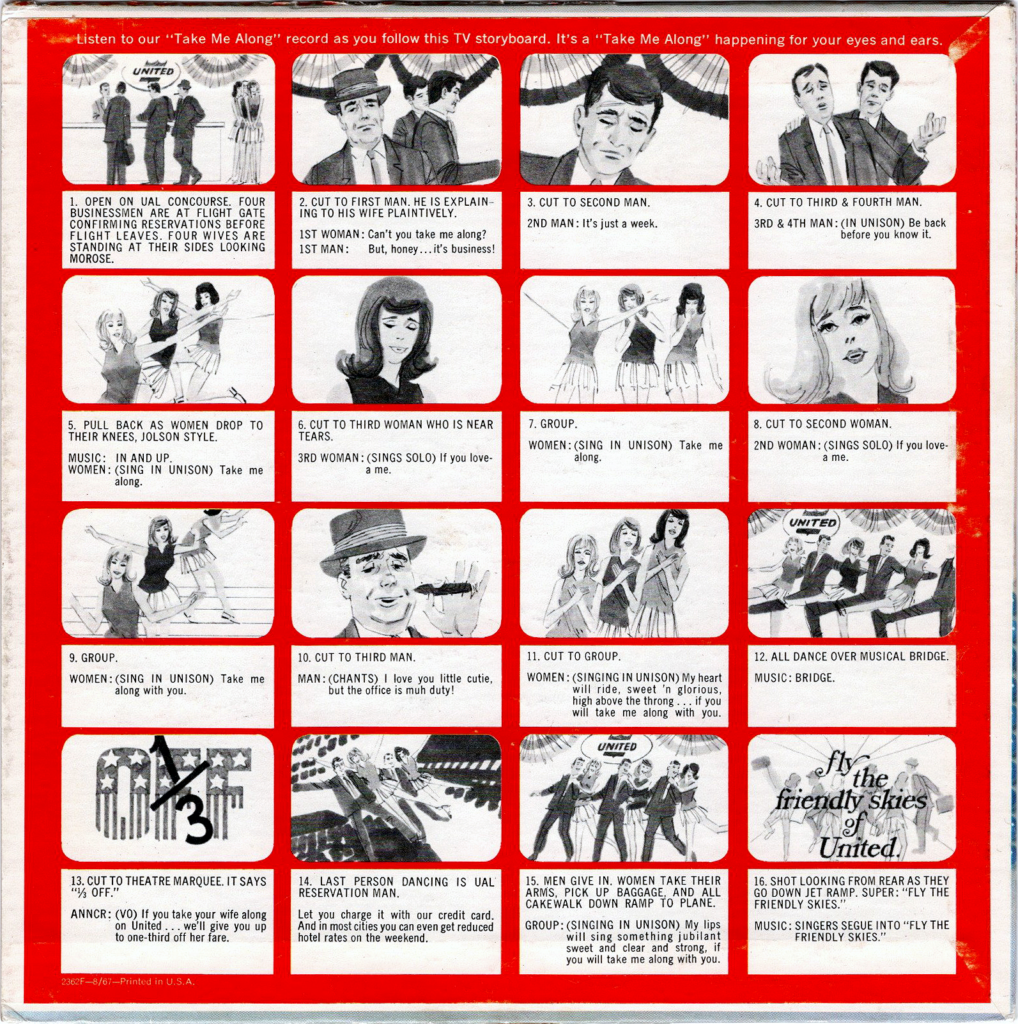Hello, audio explorers, and a big splashy welcome to another exciting installment of Finnley’s Audio Adventures! I’m your host, Finnley the Dolphin, diving deep into the quirky corners of audio history. This time, I’m coming to you from the lively hum of Wold-Chamberlain Airport, where I’m catching my next connection. Today’s journey comes courtesy of United Air Lines. Alongside my complimentary beverage and bag of peanuts, I stumbled upon an unexpected treat: a mid-20th-century advertisement that reimagines a song from a classic Broadway musical. This gem originally featured the legendary Jackie Gleason and delivers a delightful twist that stands apart from modern commercials. It’s the kind of catchy charm you’d expect to find in a pharmaceutical ad, only with more swing. So buckle up, because we’re about to take off on an audio journey that’s both unconventional and endlessly entertaining.
To better understand the roots of this musical marvel, let’s travel back to 1959 and explore the Broadway production Take Me Along. This vibrant musical was a significant moment in American theater, brimming with talent, story, and soul. At the heart of its charm is its captivating title track, a song that captures the warmth and wistfulness of the entire show.
The music was brought to life by a remarkable trio: Bob Merrill, Sid Davis, and Nat Miller. Among them, Bob Merrill stood out for his ability to craft melodies that were both engaging and emotionally resonant. Born Henry Levan in 1921 in Atlantic City, New Jersey, Merrill made a name for himself first in pop music. Hits like “Mambo Italiano” and “If I Knew You Were Comin’ I’d’ve Baked a Cake” launched his career and opened the door to Broadway.
Once he made the leap to the stage, Merrill’s impact only grew. He’s perhaps best known for Funny Girl (1964), which introduced iconic songs like “People” and “Don’t Rain on My Parade.” But his work on Take Me Along and Carnival! (1961) further showcased his ability to fuse catchy tunes with meaningful storytelling. These compositions helped bridge the gap between pop music and musical theater, creating scores that were both accessible and artistically rich.
Set in a small American town, Take Me Along tells a story of family, dreams, and heart. The score plays a crucial role in bringing the narrative to life, and the title track especially remains a shining example of melodic storytelling. Merrill, Davis, and Miller’s collaboration not only elevated the musical but left a lasting impression on audiences.
Though Merrill found great public success, he preferred a life outside the spotlight. Still, his musical legacy continues to resonate, spanning across genres and generations. His ability to adapt and innovate helped define the sound of mid-century American entertainment.
With that musical context in mind, let’s fast-forward to the 1960s. This was a transformative decade for United Air Lines, now known as United Airlines. It was an era defined by the rapid growth of the Jet Age, and United embraced the moment by modernizing its fleet with aircraft like the Boeing 720, 727, and the iconic 707. These sleek jets didn’t just increase speed and efficiency, they helped expand United’s network across the United States and into international destinations.
During this time, United also underwent strategic mergers, most notably with Capital Airlines in 1961, positioning itself among the largest carriers in the world. But the airline’s evolution wasn’t just mechanical. Technological innovation became a key part of its identity. United was one of the first airlines to implement computerized reservation systems, a groundbreaking move that revolutionized the booking process.
With faster flights and more streamlined operations came an increased focus on customer experience. Jet travel was becoming more accessible, shifting from an exclusive luxury to a common mode of transportation. United’s advertising and branding rose to meet the moment, crafting vibrant campaigns that reflected the excitement of a changing world.
These changes didn’t come without challenges. As air travel grew, airlines had to stay ahead of safety and operational demands. United, like its peers, had to navigate a tightly regulated industry where government oversight influenced pricing and routes. Yet through it all, the 1960s solidified United’s status as a major force in aviation, thanks in large part to its adaptability and vision.
Part of that vision involved working with some of the best creative minds in advertising. Enter the Leo Burnett Company, founded in 1935 and headquartered in Chicago. Known for its deeply human approach to marketing, the agency made a name for itself by creating iconic, emotionally resonant campaigns. From Tony the Tiger to the Marlboro Man to the Jolly Green Giant, Leo Burnett’s characters became fixtures of American culture.

Leo Burnett wasn’t just about flashy mascots. The agency built its reputation on crafting messages that spoke directly to everyday people. Its global reach and commitment to innovation allowed it to remain at the forefront of the industry, constantly adapting to new media and cultural trends. The agency’s work earned widespread recognition, winning accolades at prestigious events like the Cannes Lions International Festival of Creativity and contributing to social impact initiatives along the way.
In 1967, Leo Burnett brought its creative force to United Airlines through the “Take Me Along” campaign. The project was led by Michael Cimino and Dix Marx. While information on Dix Marx is scarce, Michael Cimino’s path from advertising to Hollywood is well documented.
Cimino began his career in the bustling advertising scene of 1960s New York City. There, he made a mark with his ability to tell compelling stories in the brief, punchy format of commercials. His eye for visuals and knack for structure allowed him to build narratives that resonated quickly and effectively.
This talent translated beautifully into filmmaking. Cimino’s advertising experience helped shape his cinematic style, defined by strong visual storytelling and detailed composition. His most acclaimed work, The Deer Hunter (1978), won five Academy Awards, including Best Picture and Best Director. Another major project, Heaven’s Gate (1980), faced early criticism but has since been reevaluated as a bold, visionary film. Across his work, the storytelling skills he sharpened in advertising continued to shine.
The “Take Me Along” campaign for United Airlines reflected that same creative energy. The promotional album that accompanied the campaign is a fascinating artifact. At first glance, the album cover looks fairly standard. But flip it over, and you’ll find a detailed storyboard of the commercial’s production, offering listeners a behind-the-scenes look at how the campaign was made.
As the narrator guides you through the album, the experience becomes cinematic. You can picture each scene as it’s described, following the flow of the storyboard. This immersive format mirrors Cimino’s storytelling strengths, blending narrative structure with emotional resonance. The album even includes raw outtakes from the orchestra, singers, and voice-over artists. These glimpses into the creative process highlight the contrast between rough drafts and the final version, much like the journey from script to screen in film production.

While researching the campaign, I also found a curious anecdote related to a similar promotion by TWA Airlines. Though no confirmed date was found, a 1967 column by Art Buchwald in the Daily Iowan mentioned a mix-up that caused quite a stir. According to the story, TWA mailed thank-you letters to passengers’ wives, encouraging them to share their flying experience. The twist? Many of these women hadn’t flown at all. Their husbands had apparently taken advantage of a promotional offer…with someone else. The fallout was understandably awkward. Though this tale appears to be more legend than fact, referenced also in Wikipedia and a 1958 Reader’s Digest, it underscores the risks of blending marketing with personal affairs.
So, dear audio adventurers, we’ve cruised through a rich soundscape, hopping from Broadway stages to jetliner cabins and even peeking behind the curtain of Madison Avenue. This installment has taken us through the genius of Bob Merrill, the innovative heyday of United Airlines, and the artistic ambitions of Michael Cimino, all wrapped in the engaging packaging of vintage advertising.
Our journey offered more than just entertainment. It revealed the intricate storytelling behind a seemingly simple campaign and showed how music, marketing, and memory intersect in unexpected ways. From catchy jingles to album outtakes, each element added a layer to the sonic tapestry we’ve explored today.
As we prepare to disembark from this auditory flight, remember that sound has the power to transport us through time and space. Every vintage record, old jingle, and forgotten commercial has a story waiting to be heard. Until next time, keep your fins to the waves and your ears to the skies. I’m Finnley the Dolphin, and I’ll see you soon on another splashy dive into audio history!
